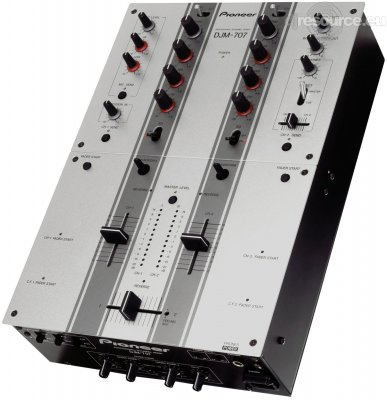Pioneer DJM-707 2 Channel Battle Mixer
Submitted by LeadThis content is © 2003-2025 The DJResource
Pioneer DJ - Mixer Overview
Gearbase product details : Pioneer DJ DJM-707
Pioneer’s DJM-707 is designed with scratch DJs, the studio / production
DJs and the Turntablist in mind, however they are also excellent units for all
DJs wanting to improve their performance level. The introduction of these two
revolutionary mixers has taken the high-end battle mixer into a whole new dimension
with features that were unknown to this industry before and now revealed for
the first time. 
Specifications
Channel Equalizers
Microphone Equalizers
Frequency Response
20Hz ~ 20kHz
Distortion
0.02 %
Signal to Noise Ratio line
87 dB
Signal to Noise Ratio phono
77 dB
Crosstalk
70dB or more (1kHz)
Power Supply
AC 220-240V, 50/60Hz
Power Consumption
30 W
Dimensions
251 x 381.6 x 107.9 ( WxDxH )
Net Weight
6.3 kg
Input Specs & Terminals
CD
2 x (RCA) 14dBV (200mV) / 22k
Phono/Line
2 x (RCA) -54dBV (2mV) / 47k
Mic
1 x (Combi Phone/XLR) -54dBV (2mV) / 3k
Session In
1 x (RCA) -14dBV (200mV) / 22k
Faderstart
2 x (mono mini JACK)
Return
2 x mono (Phone Jack 6.3mm)
Output Specs & Terminals
Master Out
1 x (RCA) 0 dBV (1V) / 1k
1 x (XLR) 2.2 dBV (1.23V) / 60k
1 x (XLR) 2.2 dBV (1.23V) / 60k
Booth/Session
1 x (RCA) 0dBV (1V) /1k
Send
1 x (RCA) -14 dBV (200mV) / 1k
Headphone Monitor Out
1 x (1/4" Phone) 0 dBV(1V)/22
Channel Equalizers
Low Frequency
-26 ~ +6 dB @ 70Hz
Mid frequency
-26 ~ +6 dB @ 1kHz
high Frequency
-26 ~ +6 dB @ 13kHz
Microphone Equalizers
Low Frequency
-12 ~ +6 dB @ 100Hz
high Frequency
-12 ~ +6 dB @ 10kHz
THERE IS NO BLACK DJM-707 !

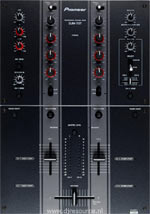 Allthough
there were a few models of the DJM-707 in black, it were only test samples.
Far before final introduction the decision was made that
Allthough
there were a few models of the DJM-707 in black, it were only test samples.
Far before final introduction the decision was made thatThe Pioneer DJM-707 would only be available in the color SILVER
The DJM-909 would be available in the colour BLACK. There are no black models of the DJM-707 available in stores, eventhough some shop show the picture of the black model : It's NOT available (nor will it ever be).
High Quality Sound Design and Durability
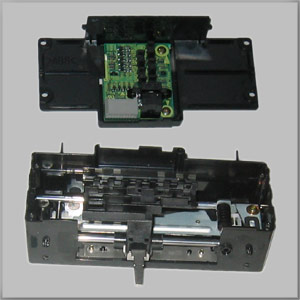 The DJM-707 boast the highest quality in sound and design that exceed today?s
battle / performance mixers offering powerful club sound in a battle mixer.
The DJM-707 boast the highest quality in sound and design that exceed today?s
battle / performance mixers offering powerful club sound in a battle mixer. This was accomplished with sensitive yet solid gripping EQ knobs, durable transform switches, and precise and accurate cross fader curve control.
Most importantly, Pioneer has developed an original ?non-contact? cross fader technology with unprecedented durability and reliability. Cracks, clicks and drop-outs in the crossfader are hardly possible.
Fader Start Sync
Both mixers can connect with Pioneer?s CDJ series to employ the fader start capability. The user can automatically start or stop playback by the sliding cross-fader or channel-fader.
When you use the FADER REVERSE function the faderstart will automaticly move to the other side of the (cros)fader. It works by the principle of : volume down -> CDJ in cue.
Mixer Layout
The DJM-707 offers a very clean, open fader area for scratching and beat juggling and has a session line-in with volume control, cueable master output, mic input, and selectable phono / line switches. There is lots of room around the area with the faders / crossfaders so nothing is in the way to bother you while performing.
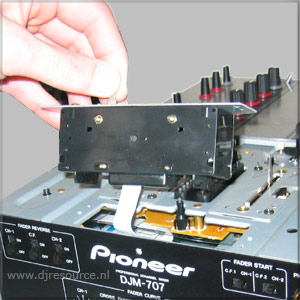
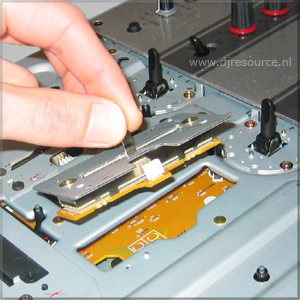
The Cross Fader and Faders
The most important feature on any battle mixer is its crossfader and fader performance. Pioneer?s DJM-707 and DJM-909 introduce the most precise and customizable cross fader in the industry to date. The cross fader is highly durable and has double fade control allowing each half of the cross fader the ability to be adjusted independently! In the unlikely event that a fader should be repaced, it's always nice to know that it's an easy job to do so. Each channel fader curve can be adjusted from a smooth volume change to a dynamic volume ON/OFF at the TIP of the channel faders (bottom or top). In turntablist slang, you will be able to crab-scratch the channel faders from either the top end or bottom end of the fader.

Adjustable Cross Fader Lag
The 'lag' of the crossfader can also be adjusted from 1mm to 6mm. The lag is the area from the crossfader from the corner to the point where that actual fader starts to open. Some people prefer a bigger area than others, this is also unique for lots of DJ's because your style could be build on the effects you make with a certain lag.
Reverse switches
Each of the faders can be reversed instantly. On the front left are the 3 switches that controll both channel-faders and the middle one is for the crossfader. The faderreverse-function includes a red LED above each fader which lights up when this function is activated.
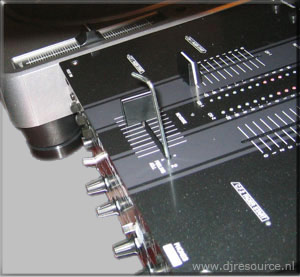 Crossfader
Feel Adjust
Crossfader
Feel AdjustThe cross fader feel can also be adjusted to your preference (a breakthrough functionality, industry-first). By easily tightening a screw you can set the feel (tightness) of the crossfader exactly as tight as you want it to be. A tool to do this is included with the DJM-707 and the DJM-909.
EQ On/Off switch
The equalizers (LOW/MID/HIGH) for each channel can be switched on and off by a lever-switch. This switch has the same grip as the TRANSFORM switch. Great for giving more accents in certain passages of the tracks you play. Use it to lift out a snare or istrument (cut down LOW and boost MID and HIGH), switch only on a certain instrument or melody and use it like a transform switch. The red LED is light up when the EQ is switched on.
Stereo Send / Return
The SEND/RETURN can be used to hook up an extra EFX-500 or any other effects module.
RCA & XLR Outputs
The output from the DJM-707 and DJM-909 is both on RCA and XLR connections to meet the standard from nowadays clublife.
Headphone Monitor auditioning
With an easy fader the monitor source can be selected. It's also possible to PreFadeListen to the master or the effects section.
Mic Input with 2-band EQ
Located on the back of the mixer is the input for a microphone. The connection-type is a Combo Jack/XLR socket so you can insert a microphone with an XLR or Phone (JACK) connector. The microphone volume is controlled on the top-left of the mixer and also had a LOW and HIGH equalizer.

Session inputs / outputs with level control
Another unique and industry-first feature is the Session In/Out connection. This basicly gives you another input with only volume control and is used when you make a battle set-up. Connect Mixer A's session OUT to the session IN from mixer B. The output from mixer A goes to the monitor amplifiers from DJ A. During the soundcheck you can make the final adjustments of the session IN and OUt controlls of moth mixers. Now the DJ's can both use their own monitor and DJ-system and without the need of a third master-mixer the battle can begin.
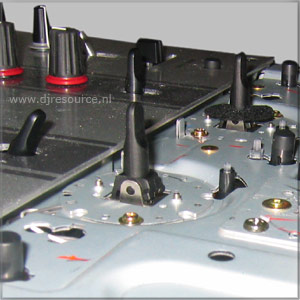 Transform
switches
Transform
switchesThe transform switches also have a unique feature that I've never seen before with this much flexibility. You can rotate the transformswitches independent from eachother in steps of 45 degrees.
The switch is 180 degrees rotatetable and is connecter to the mixer with a system-connector. Replacing a transform-switch in the unlikely event that it breaks down is as easy as opening the mixer on the top, loosen 4 screws and you have direct acces to this section of the mixer. On the picture on the right you see that the switch is originaly moving up (ON) and down (OFF).
 When you want to rotate the Transform Switches you need to unscrew the screws
marked with a GREEN arrow.
When you want to rotate the Transform Switches you need to unscrew the screws
marked with a GREEN arrow.When a Fader needs to be changed you can do so by unscrewing the RED marked screws.
And in in the case there's something wrong with the Crossfader (I wouldn't know how you could ever do such a thing) you need to use the screws that are marked with a BLUE arrow.
When you want to rotate this switch you have to unscrew the top of your mixer (4 screws) and lift the deckplate. In the picture you see marks at the screws that hold the faders and transform switches. Each fader or switch is hold to it's place by 2 screws. Unscrew only these marked screws because others have different functions!
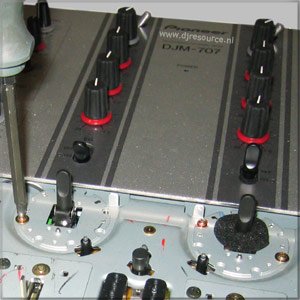 Each
of all replaceble parts are screwed to the mixer by 2 screws. Unscrew them with
a small Philips screwdriver. You can now take out the switch and move it to
the position that you desire. There are holes in the metal housing of the switch
in steps of 1/8 rotation. The wires that connects the switch to mixer has enough
length for you to move freely. If you would like to replace the switch you can
disconnect the little system-connector on the printboard that is located at
the bottom of the switch.
Each
of all replaceble parts are screwed to the mixer by 2 screws. Unscrew them with
a small Philips screwdriver. You can now take out the switch and move it to
the position that you desire. There are holes in the metal housing of the switch
in steps of 1/8 rotation. The wires that connects the switch to mixer has enough
length for you to move freely. If you would like to replace the switch you can
disconnect the little system-connector on the printboard that is located at
the bottom of the switch.Here the fader is rotated 90 degrees to work horizontaly, but you're free to set it in any position.
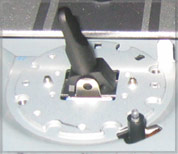
What do you think about Pioneer DJM-707 ??
Vote :
Gearbase
This content is © 2003-2025 The DJResource...
OK we understand you don't like ads (so don't we) but,
Please consider making this website possible by disabling your Ad Blocker.
Or become a Gold Member, they don't see ads.
Please consider making this website possible by disabling your Ad Blocker.
Or become a Gold Member, they don't see ads.
There are 2 Comments
Create your FREE ACCOUNT now !
Some parts of this website require you to login. Using an account on DJResource has a lot of advantages such as:
Adding Content, getting Notifications, Like content, Downloading and Uploading Images and much more.
Create your account to get involved with the Community
246 Users online: 68 Guests (178 Unknown)
Pages generated today : 28.556
Most visitors online this month : 1.134
Lifetime Pageviews since 2003 : 245.830.045
Most visitors online this month : 1.134
Lifetime Pageviews since 2003 : 245.830.045

